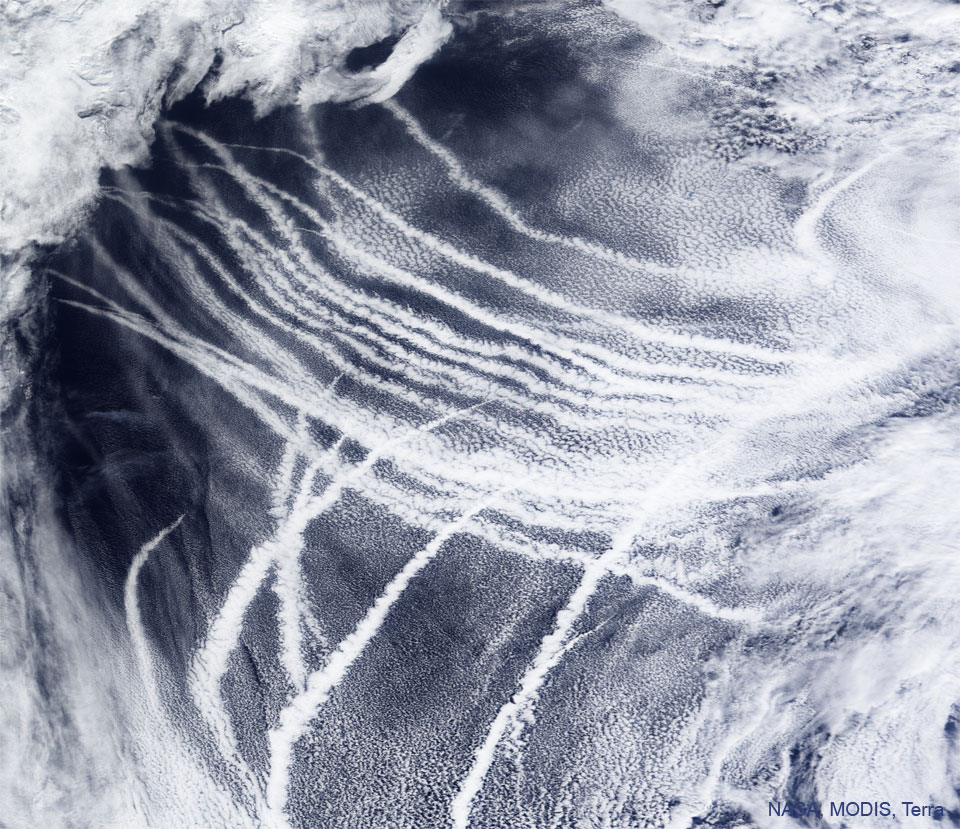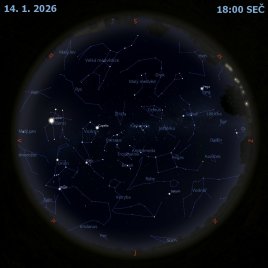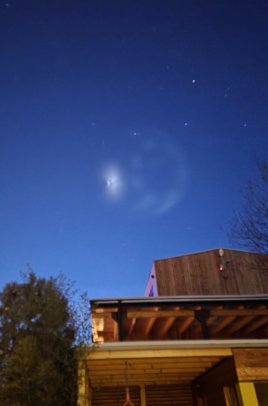Stopy lodí nad Tichým oceánem

Uznání: NASA, Terra, MODIS; Text: Raymond Shaw (MTU)
Co je zvláštní na těchto stopách? Na některých snímcích planety Země jsou zřetelně vidět jasné čáry, které sledují dráhy lodí. Tyto nízké a úzké pásy způsobují výfuky lodních motorů a jsou známy jako lodní stopy. Vodní pára kondenzuje na drobných částicích z výfuku známých jako aerosoly, které brzy přerůstají do vodních kapek, jenž efektivně odrážejí sluneční světlo. Lodní stopy byly poprvé objeveny v roce 1965 na snímcích Země, které pořídily družice TIROS. Na tomto snímku jsou vidět četné stopy lodí zachycené v roce 2009 nad Tichým oceánem přístrojem MODIS na družici NASA Terra. Někteří vědci, inspirováni lodními stopami, navrhli vytvoření sítě plovoucích bójí ve světových oceánech, které by rozprašovaly aerosol soli s obsahem mořské vody do vzduchu, takže by za pomoci větru vytvořily proudy mračen odrážejících sluneční světlo. Proč to udělat? Takové lidmi vytvořené mraky by mohly odrážet tolik slunečního světla, že by to mohlo pomoci snížit globální oteplování.
Seznam odkazů v popisu
- APOD: 2022-02-06 Modrá skleněná kulička Země
- Youtu.be: Ship's Engine Start Up
- Wikipedia: Ship_tracks
- NASA: Water Vapor
- Wikipedia: Aerosol
- APOD: 2022-03-27 Odraz slunečního světla na mořích Titanu xxx
- AMetSoc.org: Anomalous Cloud Lines
- NASA: Earth Observatory Images
- NASA: Launch of TIROS 1, World's 1st Weather Satellite — This Week in Goddard History: March 31–April 6
- NASA: Ship Tracks South of Alaska
- ScienceBits.com: On the formation of ship tracks
- Wikipedia: Pacific_Ocean
- Wikipedia: Moderate_Resolution_Imaging_Spectroradiometer
- Wikipedia: Terra_(satellite)
- NationalAcademies.org: Reflecting Sunlight: Recommendations for Solar Geoengineering Research and Research Governance
- Wikipedia: Buoy
- NASA: Ocean Worlds
- Wikipedia: Sea_salt_aerosol
- Wikipedia: Marine_stratocumulus
- Wikipedia: Marine_cloud_brightening
- Hubspot.net: Foto: Dogs-tilting-their-heads :-)
- RoyalSocietyPublishing.org: Marine cloud brightening
- NOAA.gov: Earth's Radiation Budget
- NASA: Overview: Weather, Global Warming, and Climate Change
- Oceanic.global: UNITED NATIONS WORLD OCEANS DAY 2022 - COLLECTIVE ACTION FOR THE OCEAN
NASA Official: Phillip Newman Specific rights apply. NASA Web Privacy Policy and Important Notices
A service of: ASD at NASA / GSFC & Michigan Tech. U.
Odkaz na originální APOD


